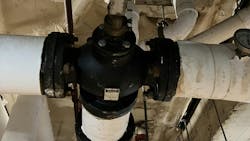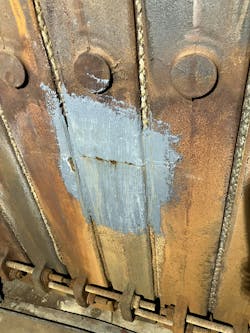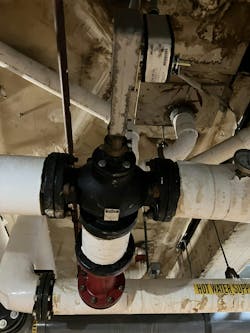What if the Boiler Stopped Working and Nobody Cared?
We’ll travel out of town for this column, sixty miles north to the city of Dayton, Ohio, which was an industrial hub back in the day. Machine tools made in my hometown, Cincinnati, were shipped to Dayton to make cash registers and aerospace parts.
I’ve noticed that the more industrial towns have more boiler installations. Dayton qualifies, with some residential applications being over-engineered. Today though, we were meeting in the urban section, just a few blocks outside the city’s downtown center.
A Boiler with a Crack
When I got there, I had to park down the street at a regular parallel parking spot. In front of the building, the city wants you to back into diagonal spots. I don’t understand the logic of going backwards against oncoming traffic.
I met the contractor and building management representative in the alley behind the building, a row of maybe a dozen or more four-story brick buildings from the early 1900’s now joined together as a collection of loft apartments above storefront retail.
It was renovated about twenty years ago into its current configuration. Previously the area and buildings were part of a thriving cannery district. Today we’re going to look at a boiler with a crack and come up with a “big picture” concept of how to move forward.
The management guy was leading us to the boiler in the basement as well as giving us a timeline of his history with the boiler, which was only a couple of years. Amazingly, he said they operated last winter with the boiler off the whole season because of the leak.
Not One Complaint?
The secret to operating an old building without running the boiler turns out to be the type of system. The concept of this system is using water source heat pumps, which extract heat from the water circulating through the piping. As long as the water is above a certain temperature, the individual heat pumps can keep the apartments and storefronts warm.
Surprisingly, not only did the building operate without the boiler working, the manager said he didn’t get one complaint. Now, I’m wondering if he’s being honest. But the saving grace of this system is where the water is being piped.
There are two plate and frame heat exchangers in the center of the basement. On one side is the water that circulates through the building. On the other side, the water is pumped in and out of the ground. This arrangement is usually called “pump and dump”.
Under this building, and throughout a good part of southwestern Ohio, is the Great Miami aquifer, a bountiful reservoir of water at a consistent temperature—even in extreme outdoor conditions—because it is 200 feet below the surface. To believe the boiler-less operation of last year, that temperature would have to be above the lowest operating water temperature for the water source heat pumps.
Cold Shock
We headed to the boiler room to check on the boiler and found a 3 million btu commercial cast iron boiler with its sheet metal jacket removed. As you can see in the photo, there is a horizontal crack across the section, about halfway up. The rep reported that a different section was replaced sometime in the past.
What you can’t see in the photo is a return pipe to the boiler a section over. This type of crack is generally referred to in the industry as “cold shock,” which means that a hot cast iron section has been subjected to cold water, which causes the section to crack horizontally.
This can happen to any brand of cast iron boiler, since it is the nature of cast iron metal. A careful installation of a cast iron boiler with the possibility of experiencing a stream of cold water should include protection from that happening. In the boiler room was just the boiler, no pumps, just a supply and return pipe going through the wall. We traced it back about a hundred feet to the equipment room with the heat exchangers.
Valve Failure
There we found the boiler loop pump and the three-way valve shown in the other photo. The hot water in the bottom right pipe is connected to a tee, with the branch facing towards and connected to the three-way valve. The flow in the supply pipe is from right to left towards a primary- secondary connection on the main building piping.
If the three-way valve is open to the hot supply, closed to the cold return from the system, then the boiler water is re-circulated to the boiler until the water temperature gets above, say, 140°F. (You can see a dial thermometer on the pipe heading back to the boiler.)
Then the valve starts to blend the warm water from the boiler through the valve to mix with the cold water coming back from the water source heat pumps, maybe as low as 40°F, maintaining 140°F going back to the boiler. Whatever water doesn’t get by-passed flows out to the primary-secondary connection to warm up the building loop.
The valve must have failed at some point to mix hot water over to the return. That would allow the cold water to circulate directly back to the boiler. It wouldn’t take long for that hundred feet of return piping to drop in temperature, since the boiler loop pump is cranking out about 250 gallons per minutes.
Big Picture
That cold water hits the hot boiler and the cast iron can go snap. The valve, control and boiler section could all be replaced, but I suggested a switch to modulating-condensing technology as the “big picture” solution. The rep liked the idea of putting in two boilers for redundancy and downsizing the total output, since the system worked boiler-less last season.
Mod-cons love cold return temps, and in this application will be condensing flue gasses whenever in operation. I also quoted a high efficiency boiler loop pump so the existing boiler loop pump can become the back-up. The three-way valve that caused the problem would be eliminated with the mod-con installation.
About the Author
Patrick Linhardt
Patrick Linhardt is a forty-one-year veteran of the wholesale side of the hydronic industry who has been designing and troubleshooting steam and hot water heating systems, pumps and controls on an almost daily basis. An educator and author, he is currently Hydronic Manager at the Corken Steel Products Co.


